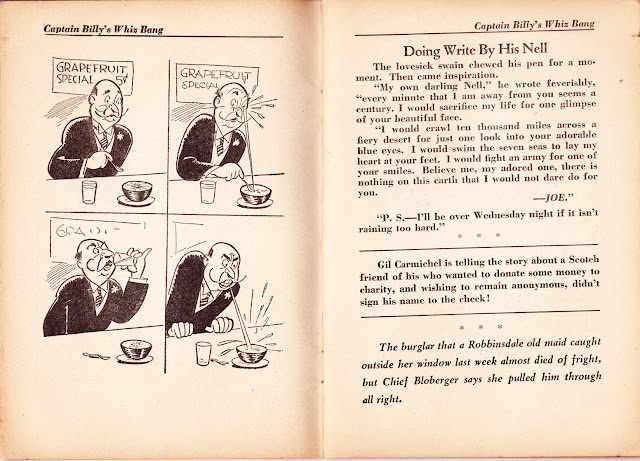Here's something from great grandad's attic: a copy of Captain Billy's Whiz Bang. A "naughty" magazine in its day. This is Volume IX No. 188, June 1934 and was published monthly by Popular Magazines Inc. in Minneapolis, MN.
Captain Billy's Whiz Bang was a pocket-size bawdy joke magazine
that was published by Captain Wilford Hamilton Fawcett AKA "Captain
Billy" (1885 - 1940). I had heard of it, but never actually seen a copy
until I saw a few copies at the Two Brothers used bookstore in Freeport,
ME this past Sunday. Without this popular racy humor digest that had
its heyday 100 years ago, there would be no Captain Marvel or Popular
Mechanix magazines.
Here's the story:
Fawcett
lied about his age when he was 16 to go fight in the Spanish-American
War. After that, he came home and then worked as a police reporter for
the Minneapolis Journal until
World War 1. He went off to fight again. Fawcett achieved the rank of
captain and worked at Stars and
Stripes. It was while he was there that he got the idea for Captain
Billy's
Whiz Bang. The title was a combination of his nickname, and the name of
a WW1 bomb. After the war, he began publishing the risque digest. In
1921, he was quoted as saying that the
racy humor mag was closing in on a circulation of a million. (Records
show that circulation was actually more like nearly half that, at
425,000 copies a month at its peak.)
From
Captain Billy's Whiz Bang, Fawcett and his sons created other magazines:
detective magazines, movie gossip magazines, and others, like the
long-running Family Circle and Woman's Day mags. Perhaps its crown jewel
was Mechanix Illustrated.
After their
father's death in 1940, Fawcett's sons began a line of comic books modeled on
the popular Superman character at DC Comics. Fawcett Comics published a
line of comics including Captain Marvel. (Captain Marvel debuted in Whiz
Comics, which I think was a nod to the magazine and the dad who started
it all.) DC sued Fawcett for copyright infringement, saying Marvel was
way too much like Superman. The case dragged on for years. In the 1940s,
the Captain Marvel family of comic books outsold Superman's. Pushing
the lawsuit ahead was affordable while sales were brisk, I suppose. (Captain Marvel Jr. had
such an impact on Elvis Presley that he borrowed the character's poses,
hairstyle and lightning flash chest insignia, as described in Elaine
Dundy's biography, Elvis and Gladys.)
After
WW2, sales began to decline and Fawcett Publications folded its line of
comics. The company had already ventured into the profitable world of
paperbacks with the Gold Medal line.
About the magazine:
It's also cheesy, dated, male chauvinistic. It's a collection of gossip and funny stories and Captain Billy's own stories of his travels and the famous people he hob-nobbed with. There are a series of departments for stories, all with funny titles like "Drippings from the Faucet," "Button Busters," "Howls from Harlem," "Smokehouse Poetry," and so on. There's a kinda nod to the gay culture with a page of "Queeries and Nancers" with faux editor "Percy McNance" and associate editor "Algy Devere." And there's even a reference to a woman's "time of the month" in one of the gag cartoons.
Bill Holman, just a year before his long-running newspaper strip Smokey Stover debuted, is in the mix in this particular issue with one gag cartoon (opposite "Queeries and Nancers"). A fair number of the single panel cartoons are unsigned. Most all are more than competently executed. (The "tramp" cartoon and the "Major's operation" cartoon are particularly skilled.) Some of the signed contributors include Jimmy Caborn (1909-1955), who would go on to work for the Plain Dealer (interrupted for three years when he enlisted into the army in 1943) and create a couple of syndicated features, while doing a lot of freelance work for The Saturday Evening Post, Collier's and other major magazines; Bob Gesteland, who freelanced for magazines and was part of the Disney stable for at least the 1930s and 40s (pretty much no information on him online); there's even a "Campus Rumpus" section with a couple of cartoons from college publications; and there are other cartoonists, with some terrific skills, who either don't sign or there is a signature or mark that I cannot make out. For some, Captain Billy's may have been beneath their status.
Via Wikipedia: The book Humor Magazines and Comic Periodicals notes:
Few periodicals reflect the post-WW I cultural change in American life as well as Captain Billy’s Whiz Bang. To some people [it] represented the decline of morality and the flaunting of sexual immodesty; to others it signified an increase in openness. For much of the 1920s, Captain Billy’s was the most prominent comic magazine in America with its mix of racy poetry and naughty jokes and puns, aimed at a small-town audience with pretensions of "sophistication."But despite its shameful humor, it was a money maker and, most importantly to a freelancer, the checks cleared.
- Edited from a blog entry of July 16, 2020.


























4 comments:
A bunch of public domain Whiz Bang's are available to read online at comicbookplus.com (free membership if you want to download).
The one reference most people recognize is in "The Music Man". As with mentions of Sen-Sen and Bevo, it's not a matter of recognition but context that indicates it's mildly illicit.
"Is he starting to memorize jokes out of Captain Billy's Whiz Bang?"
"TROUBLE TROUBLE TROUBLE TROUBLE ..."
Well, I thought it was funny. Sorry your monocle fell off.
And the Music Man reference was anachronistic, as the story was set in 1912 and the magazine was post-WWI.
Post a Comment